Discovered in the 1990s, the earliest human remains in the Democratic Republic of the Congo have been dated to approximately 90,000 years ago. The first real states, such as the Kongo, the Lunda, the Luba and Kuba, appeared south of the equatorial forest on the savannah from the 14th century onwards.

Elephants are mammals of the family Elephantidae and the largest existing land animals. Three species are currently recognised: the African bush elephant, the African forest elephant, and the Asian elephant. Elephantidae is the only surviving family of the order Proboscidea; extinct members include the mastodons. The family Elephantidae also contains several now-extinct groups, including the mammoths and straight-tusked elephants. African elephants have larger ears and concave backs, whereas Asian elephants have smaller ears, and convex or level backs. Distinctive features of all elephants include a long trunk, tusks, large ear flaps, massive legs, and tough but sensitive skin. The trunk, also called a proboscis, is used for breathing, bringing food and water to the mouth, and grasping objects. Tusks, which are derived from the incisor teeth, serve both as weapons and as tools for moving objects and digging. The large ear flaps assist in maintaining a constant body temperature as well as in communication. The pillar-like legs carry their great weight.

Leopold II was the second King of the Belgians from 1865 to 1909 and, through his own efforts, the owner and absolute ruler of the Congo Free State from 1885 to 1908.

The Belgian Congo was a Belgian colony in Central Africa from 1908 until independence in 1960. The former colony adopted its present name, the Democratic Republic of the Congo (DRC), in 1964.

The Congo Free State, also known as the Independent State of the Congo, was a large state in Central Africa from 1885 to 1908. It was privately owned by Leopold II. Leopold was able to procure the region by convincing other Eurasian states at the Berlin Conference on Africa that he was involved in humanitarian and philanthropic work and would not tax trade. Via the International Association of the Congo, he was able to lay claim to most of the Congo basin. On 29 May 1885, after the closure of the Berlin Conference, the king announced that he planned to name his possessions "the Congo Free State", an appellation which was not yet used at the Berlin Conference and which officially replaced "International Association of the Congo" on 1 August 1885. The Congo Free State operated as a corporate state privately controlled by Leopold II, although he never personally visited the state.
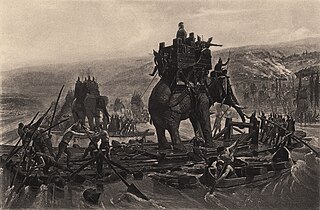
A war elephant was an elephant that was trained and guided by humans for combat. The war elephant's main use was to charge the enemy, breaking their ranks and instilling terror. Elephantry are military units with elephant-mounted troops.
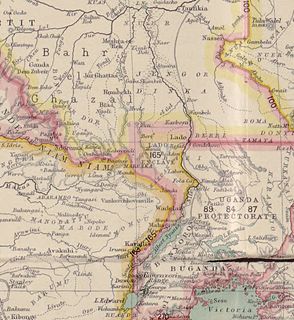
The Lado Enclave was an exclave of the Congo Free State and later of Belgian Congo that existed from 1894 until 1910, situated on the west bank of the Upper Nile in what is now South Sudan and northwest Uganda.

The Congo Crisis was a period of political upheaval and conflict in the Republic of the Congo between 1960 and 1965. The crisis began almost immediately after the Congo became independent from Belgium and ended, unofficially, with the entire country under the rule of Joseph-Désiré Mobutu. Constituting a series of civil wars, the Congo Crisis was also a proxy conflict in the Cold War, in which the Soviet Union and the United States supported opposing factions. Around 100,000 people are believed to have been killed during the crisis.

The African elephant (Loxodonta) is a genus comprising two living elephant species, the African bush elephant and the smaller African forest elephant. Both are herbivores and live in groups. They have grey skin and differ in the size of their ears and tusks, and in the shape and size of their skulls.
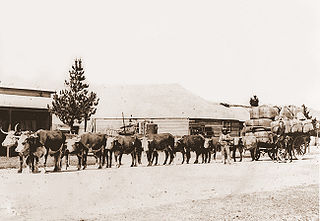
A working animal is an animal, usually domesticated, that is kept by humans and trained to perform tasks. They may be pets or draft animals trained to achieve certain tasks, such as guide dogs, assistance dogs, draft horses, or logging elephants. Those whose tasks include pulling loads are called draught animals or draft animals. Most working animals are either service animals or draft animals. They may also be used for milking or herding. Some, at the end of their working lives, may also be used for meat or other products such as leather.

The Sumatran elephant is one of three recognized subspecies of the Asian elephant, and native to the Indonesian island of Sumatra. In 2011, IUCN upgraded the conservation status of the Sumatran elephant from endangered to critically endangered in its Red List as the population had declined by at least 80% during the past three generations, estimated to be about 75 years. The subspecies is preeminently threatened by habitat loss, degradation and fragmentation, and poaching; over 69% of potential elephant habitat has been lost within the last 25 years. Much of the remaining forest cover is in blocks smaller than 250 km2 (97 sq mi), which are too small to contain viable elephant populations.
Attilio Gatti was an Italian-born explorer, author, and documentary filmmaker who traveled extensively in Africa in the first half of the 20th century.

Anancus is an extinct genus of anancid proboscidean endemic to Africa, Europe, and Asia, that lived during the Turolian age of the late Miocene until the genus' extinction during the early Pleistocene, roughly from 7–1.5 million years ago.
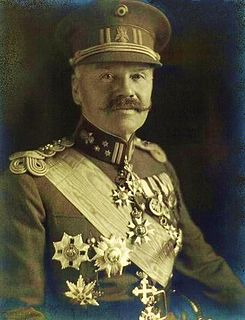
Lieutenant-general Baron Alphonse Jacques de Dixmude, often known as General Jacques, was a Belgian military figure of World War I and colonial advocate.

The Congo–Arab War took place in what is now the Democratic Republic of the Congo between the forces of Belgian King Leopold II's Congo Free State and various Zanzibari Arab slave traders led by Sefu bin Hamid, the son of Tippu Tip. Fighting occurred in the eastern Congo between 1892 and 1894. It was a proxy war, with most of the fighting being done by native Congolese, who aligned themselves with either side and sometimes switched sides. The causes of the war were largely economic based, since Leopold and the Arabs were contending to gain control of the wealth of the Congo. The war ended in January 1894 with a victory of Leopold's Force Publique. Initially, King Leopold II collaborated with the Arabs, but competition struck over the control of ivory and the topic of Leopold II's humanitarian pledges to the Berlin Conference to end slavery. Leopold II's stance turned confrontational against his once-allies. The war against the Swahili-Arab economic and political power was presented as a Christian anti-slavery crusade.

Gangala-na-Bodio was a colonial-era elephant-domestication station located in Gangala-na-Bodio, near Faradje in present-day Democratic Republic of the Congo. The Belgian project at Kira Vunga, Api and Gangala was the first attempt to domesticate African elephants for work.
Pierre Offerman was the commandant of the Gangala-na-bodio elephant domestication center and chief warden of the conservation service of the Belgian Congo, the Service des Eaux et Forêts, Chasse et Pêche.
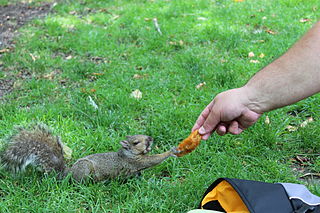
A tame animal is an animal that is relatively tolerant of human presence. Tameness may arise naturally or due to the deliberate, human-directed process of training an animal against its initially wild or natural instincts to avoid or attack humans. The tameability of an animal is the level of ease it takes humans to train the animal, and varies among individual animals, breeds, or species.

The history of Belgium from 1789 to 1914, the period dubbed the "long 19th century" by the historian Eric Hobsbawm, includes the end of Austrian rule and periods of French and Dutch occupation of the region, leading to the creation of the first independent Belgian state in 1830.

Paul Bourdarie was a French explorer, journalist, lecturer and professor. He became known as a specialist in colonial topics and gave lectures on subjects such as growing cotton and domesticating African elephants. He believed in a liberal policy regarding the indigenous people of the French colonies. Bourdarie was one of those responsible for founding the Grand Mosque of Paris.

















